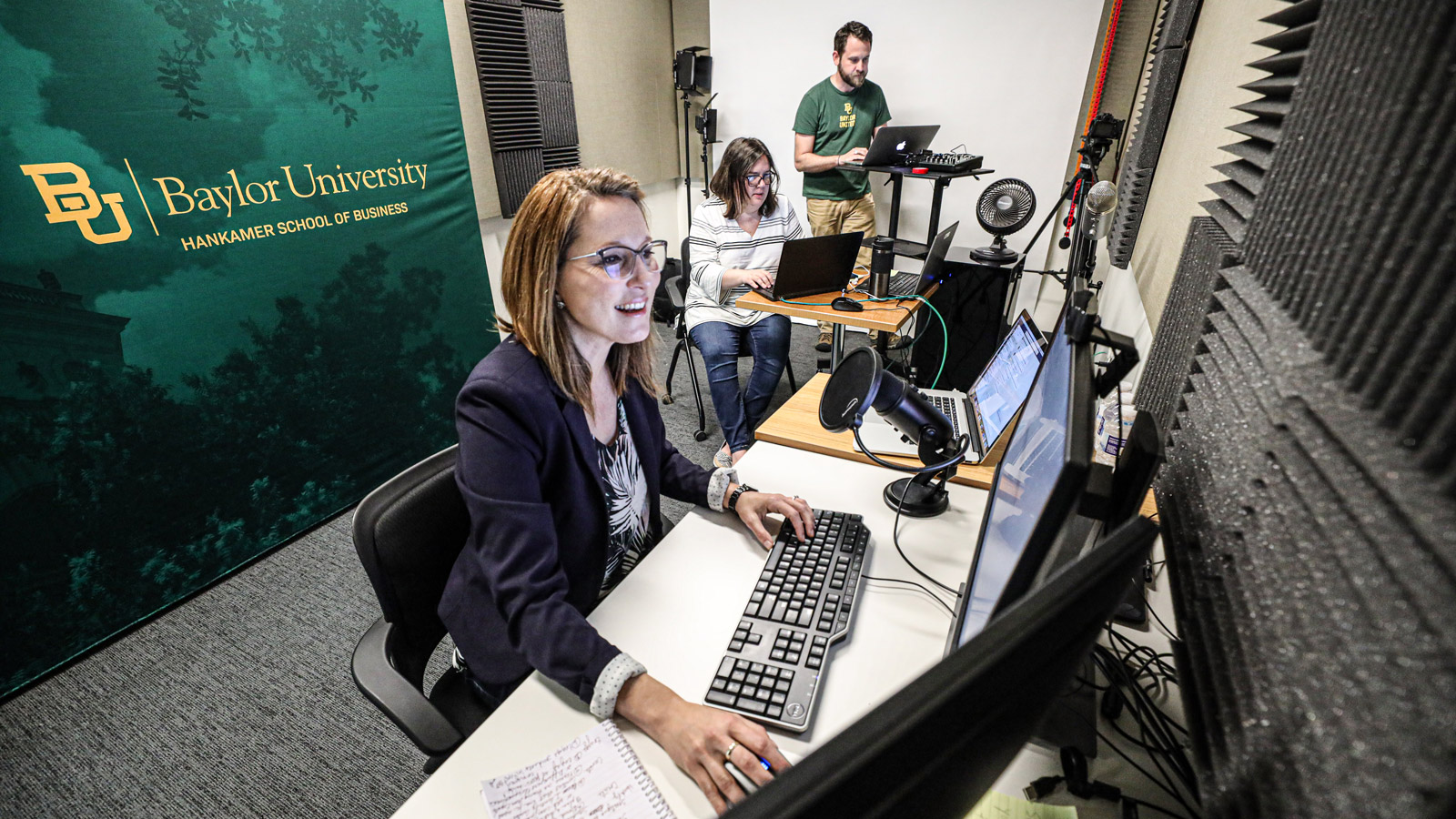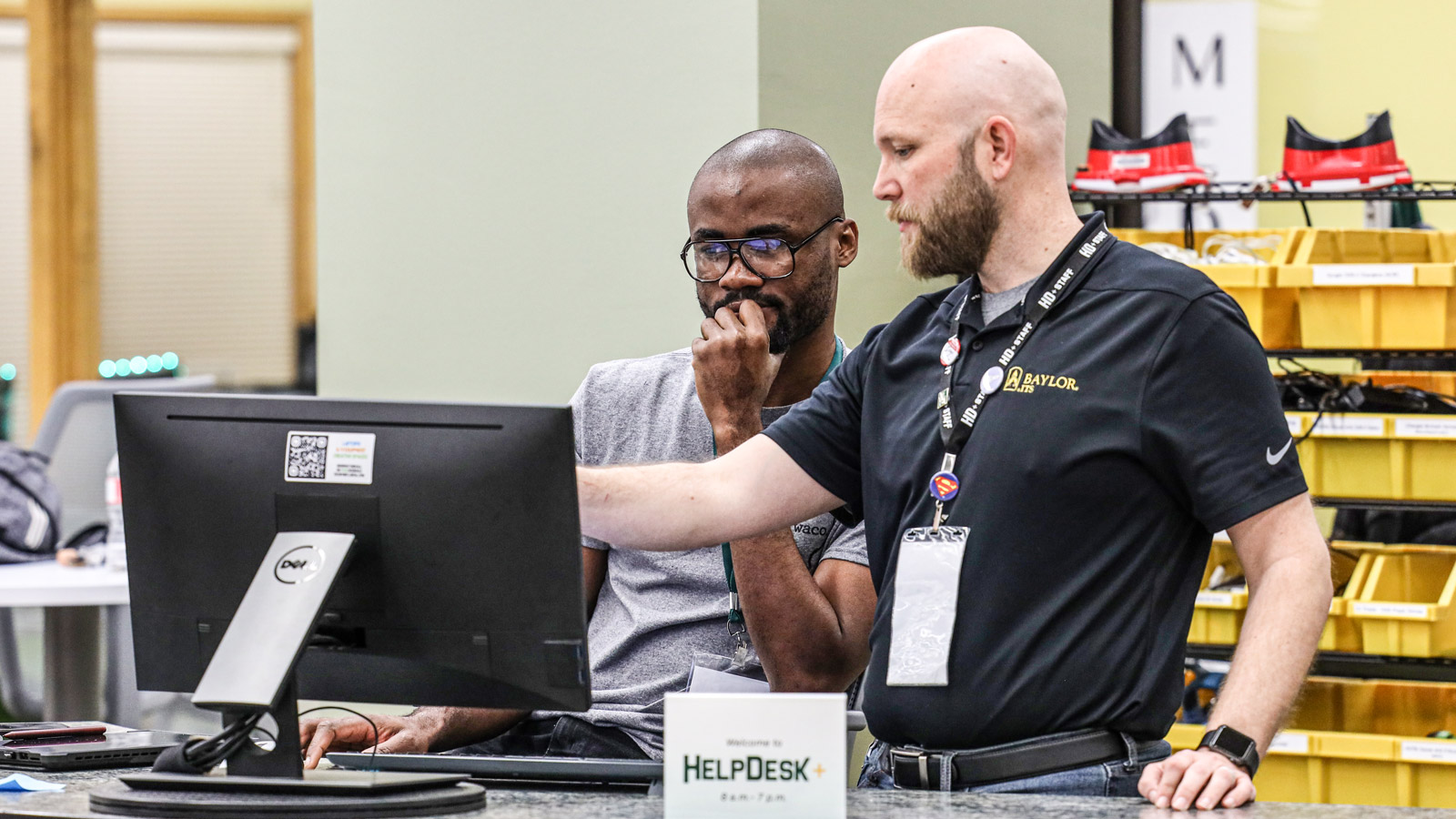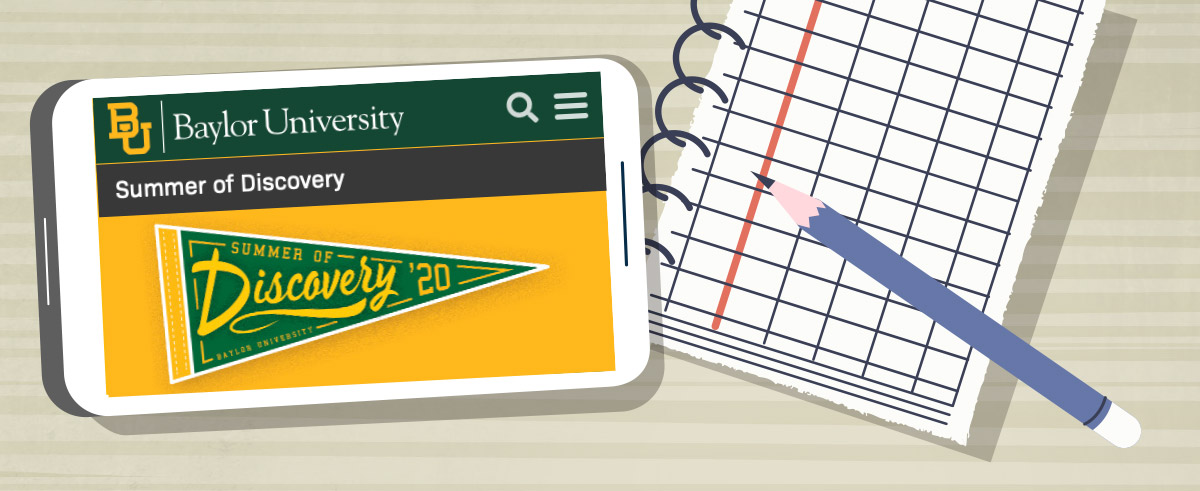Flipping the Script
Teams throughout campus make shifting Baylor's educational experience to the virtual world mid-semester possible.
An extra week of spring break? What normally would be cause for celebration became the ultimate timed exam for Baylor administrators, faculty and staff. The University had to learn fast for the semester to be saved. The clock was ticking.
Baylor’s Information Technology Services (ITS), Library and Academic Technology Services (LATS), the Academy of Teaching and Learning (ATL), and the Teaching and Learning with Technology Committee (TLTC) were among the many groups and individuals who worked overtime to build tools, enhance systems, supply training and troubleshoot issues so that faculty could successfully shift to remote classrooms mid-semester.
“Each of these groups, and the faculty who changed course very quickly, display Baylor’s deep commitment to our students and their learning, no matter what challenge comes our way,” Dr. Lenore Wright, MA ’95, associate professor of philosophy in the Honors College and ATL director, says. “Faculty are maintaining that distinctive part of Baylor, the human touch. It’s very palpable to me, even in this context.”
Adjusting instruction from in-person to online in the middle of the semester is much different than starting an online course. Faculty are not able to replicate every element of an in-person course, and asynchronous assignments and activities are appropriate because most students have had serious changes to their schedules with the student body spread through time zones around the world. Across the University, faculty and staff with technical or pedagogical expertise connected with those relatively new to online teaching and learning.
Dr. Wesley Null, vice provost for undergraduate education and institutional effectiveness, says people throughout the University locked arms to get the job done.
“I watched Baylor completely transform itself in three weeks,” Null says. “The ingenuity, the creative spirit and the perseverance that has always driven Baylor certainly came to life in meeting this challenge. Whether a Baylor education is delivered face to face or online, it’s going to be distinctive because of our faculty and the way in which they approach the subject matter they teach.
“The faculty has done their part, but the ITS and LATS groups also stepped up to showcase what Baylor can do from a technological perspective as a university, doing very hard work.”
Tech Savvy
Micah Lamb, BBA ’02, EMBA ’19, is senior director of ITS Projects and Governance. ITS was heavily involved in laying the technical groundwork for remote learning and, along with LATS and other technology groups, did a tremendous amount of work in March.
“If this weren’t a crisis, it would be a lot of fun,” Lamb says.
One example was increasing the virtual private network (VPN) capacity from 250 to 8,000, allowing faculty and staff to connect to secure campus servers from off campus. A change that substantial would normally take up to two months. It happened in one day.
Lamb says other sizeable tasks included providing timely, essential remote tech support through Baylor’s HelpDesk and ensuring students and faculty gained remote access to critical software and equipment. In effect, ITS created virtual computer labs in the cloud and turned them over to lab administrators across campus.
“It’s not as visible because you have to be in certain courses to even know that it happened,” Lamb says. “But for those students, it’s the difference between being able to complete their class or not.”
Lamb says the President’s Excellence Fund (an emergency relief fund established by Baylor President Linda A. Livingstone, Ph.D.) and Bear Care program (faculty and staff volunteers who are connecting with individual students to aid in their success) helped fill in the gaps.
“What makes our response particularly ‘Baylor’ is that from top to bottom, everyone wants the students to succeed, but the priority seems to be, ‘Is everybody OK while we’re doing it?’ We don’t want anyone to feel isolated. It reminds me why I work here. You realize others are working so hard because they love this place, too.”
Training Professors
In late February, when China transitioned its universities online, the LATS (formerly known as the Electronic Library) team began thinking about how Baylor could do the same. LATS had some existing framework, as Sandy Bennett, assistant vice provost for Graduate Professional Education, had created a basic training website for online teaching during the 2009 H1N1 crisis.
LATS created new tutorial videos and offered live training sessions for the faculty, increasing frequency from once per month to six per day. More than 1,000 faculty participated in training sessions in March.
“A lot of people stepped up, doing things that are completely outside of their area of expertise,” LATS Associate Vice President David Burns, BA ’92, MSEd ’01, says. “We knew the tools to teach were going to be key. Obviously, faculty didn’t have the luxury of taking their time with this, so we had to move quickly. What we were able to do (with training) was an undertaking but nothing really compared to the work of the faculty and the students.”
Faculty Respond
Dr. Amy Goodman, mathematics faculty member and TLTC chair, was better prepared to go online than most. When the committee met March 6, it was decided that departments should know classes might be dismissed at Easter. Four days later, the decision was made to go online immediately. Goodman says some faculty may have experienced what she calls technological whiplash.
“Once they’ve figured out how to use the tools, then they have to figure out how to convert their content for online delivery. It was a quick week,” she says.
Goodman piloted an online business calculus class in 2017. She says the biggest challenge for math in an online environment is assessment, which requires students to show their work — difficult to translate online.
With an ATL research grant, Goodman investigated ways for students to submit handwritten work online fluidly. Right before spring break, Goodman had a breakthrough and figured out a quick, efficient process.
“As soon as Baylor had to go online, I started sharing my process with all the math faculty, chemistry, biology, physics, and others that I thought were going to need to show handwritten work,” she said.
Goodman also created 10-minute videos on teaching with technology and shared them with faculty across disciplines. Additionally, she offered instructional design support for her mathematics department colleagues. Goodman says it led to a “Kumbaya moment” in a TLTC meeting.
“Having to make a quick teaching transition required us as faculty to dialogue more openly and directly about our teaching practices and to share those with each other,” she says. “A lot of people are coming out of their silos, looking around and saying, ‘How are you doing it?’ It resulted in a wealth of good ideas.”
Goodman now uses her class discussion boards as a way her students — now located throughout the world — can share about their loved ones affected by the crisis and receive prayer.
“I didn’t ever foresee that kind of intersection of faith and learning in calculus, but it’s been really heartwarming,” she says.
Dr. Doug Weaver is a Baptist studies professor, director of undergraduate studies in the Department of Religion and director of The J.M. Dawson Institute of Church-State Studies. He was less experienced with online teaching.
Weaver’s graduate seminar with five students transitioned to Zoom meetings but didn’t change much, sans his normal practice of sharing donuts in class. He has taught since 1986 and at Baylor since 2003. Weaver is the only person on campus to teach a super-
section of REL 1350 Christian Heritage with 238 students in Draper 130.
Normally, Weaver arrives to class 15 minutes early so he can talk with students, giving a large class a more personal touch. For the online transition, Weaver and his graduate assistant created voiceovers for all his PowerPoint slides and added supplemental short videos to Canvas, the online teaching platform. He also offered more study sessions to smaller groups so questions could be asked more easily.
“Online teaching is new for many on campus, but I’m happy to do it under these circumstances,” Weaver says. “I have a commitment to this common core class. It’s a terrible time, but even in this large class, students still care about doing their work. We’re doing the best we can.”
Dr. Anne-Marie Schultz, named a Master Teacher this spring, is director of the Baylor Interdisciplinary Core. Among the courses she teaches is PHI 5350 Workshop in Teaching Philosophy for graduate students who are soon-to-be instructors of record.
“This class is a testament to Baylor’s commitment to transformative undergraduate education because we want to make sure that our graduate students are well prepared when they go into the classroom,” Schultz says. “It’s actually been the perfect class to be teaching right now because teachers are all having to cope with a very different kind of reality, pushing us all to learn new things.
“Baylor is still Baylor — the commitment that students have for learning and that teachers have to teaching. We’re still the Baylor Family, even though we’re doing it remotely. A lot of the things about classroom teaching still apply: getting students involved in the conversation, being organized and creating a sense of community. All of that is really happening.”
While Baylor had no choice but to adapt, Null says Baylor’s commitment to a transformational undergraduate education remained unchanged.
“The collaborative efforts of ITS, ATL and LATS really made things happen so that faculty could keep teaching and students could keep learning,” Null says. “The question becomes: How do we adapt who Baylor is — a Christian research university — to this new world that we’re moving into? Technology helps us to deliver that piece of education so that, in the midst of all this change and uncertainty, we can continue to form students into the people God expects them to become.”
Summer of Discovery
In addition to the spring semester adjustments, Baylor also addressed the in-person restrictions impacting summer courses by launching 2020 Summer of Discovery, an innovative collection of discounted summer course bundles for current students, incoming freshmen and rising high school seniors in an online environment to help them advance toward their academic goals.
Classes are taught online by Baylor faculty in the supportive Christian environment that is a hallmark of a Baylor education. Students learn alongside their peers and have the assurance that these classes support most degree plans and majors. For rising high school seniors, Baylor’s Summer of Discovery offers opportunities to take online Baylor courses at discounted rates for college credit and potential early admission.
Summer of Discovery courses began in May and run through Aug. 12, across multiple summer sessions.
Response to the program was overwhelming with 4,782 current students, 603 first-time freshmen and 351 rising high school seniors signing on. Factoring in transfer, graduate and seminary students, the resulting enrollment topped 6,000, making it the largest summer school enrollment at Baylor in 20 years.


